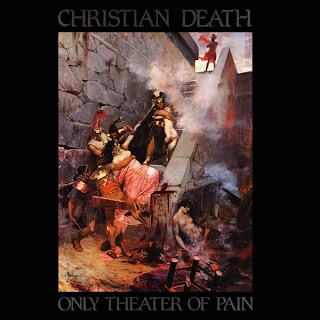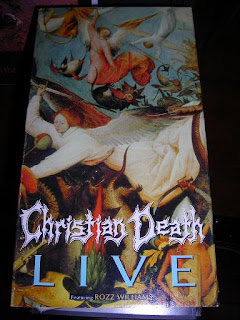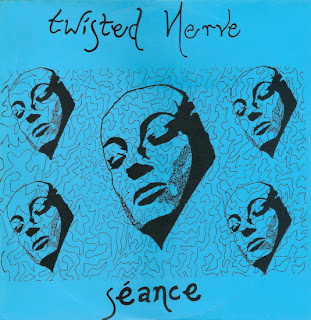Why, I do thank you all for your politely feigned surprise,
but I think we all know that just like bands who leave their biggest single for
their supposedly “impromptu” third encore, that discussion of this infamous
little number was inevitable sooner or later. After all, as Mick Mercer once
famously wrote;
“Christian Death are the ultimate life is art, art is life brigade. To
scoff at them is to wear a huge neon sign stating ‘I Am A Retard’ above your
head.” (The Gothic Rock Black Book, Omnibus Press, 1988).
This of course leaves us with the interesting problem of
what to say about an album so diabolically influential (in both the figurative
and literal sense) that hasn’t been said before?
Perhaps we should begin at the beginning as the Red King sagely
advised the White Rabbit?
In this particular tale, the beginning lies with a young man
named Roger Painter, who perhaps largely through teenage rebellion against his
highly religious upbringing became deeply involved in the burgeoning Los Angeles punk scene
and began performing in a variety of small bands. Critical mass is reached
however in 1979 when young Roger takes the stage name that would make him an
alternative icon from a gravestone he found, becomes known as Rozz Williams and
forms the original Christian Death. What makes this feat even more
extraordinary though, is when you do the math and realise that the visionary
Rozz Williams was only 16 at the time.
The original line-up of Christian Death consisted of Rozz, Jay
who had worked with Rozz in an earlier project known as Daukus Karota, James
McGearty, and George Belanger.
The band name is commonly reported as having been a pun on “Christian Dior”. If this is true
however, then it’s neither a very good nor amusing pun and I’ve often
speculated that young Rozz may have been pulling legs and that the name was
actually a statement of intent. At the very least, if one can lead a good
Christian life, then it does logically follow that one can also experience a “Christian Death”.
Those early gigs must really have been something to behold;
a heady mix of occultism, bizarre hair, even more bizarre make up, drugs and
Rozz wearing what virtually amounted to drag. With the possible exceptions of the transexuality of Wayne/Jayne County
& The Electric Chairs or Nervous Gender, American punters at the time can’t
really have seen anything quite like it, let alone the Satanic aspects, and
hostile audiences were common. It’s a genuine loss to alternative culture that
no live footage of early Christian Death performances remain. (That I know of that
is – If you’ve got some bootleg footage, no matter how bad, for the love of God
Montresor, post it on YouTube and hear
the chants of ten thousand old Death Rockers praising your name).
Nevertheless, things were on the move. The band replaced Jay
with former Adolescents’ guitarist Rikk Agnew and managed to get their track “
Dogs” included on the compilation Hell
Comes to Your House (Bemisbrain Records, 1981). I really must grab a copy of
this – apart from the narscent Christian Death, the album also features early
contributions from 45 Grave and The Superheroines, whose vocalist Eva O would
later contribute backing vocals to the Only Theatre of Pain album and end up
married to Rozz. (A warning to the unwary: Don’t confuse this with the later
compilation
Hell Comes to Your House (Music for Nations, 1984) which
is a metal compilation and will grace you with such luminaries as Manowar,
Exciter and Anthrax, and likely leave you very confused).
The Bemisbrane Records (1981) compilation - yes,
you want this version, not the other one

Their appearance on Hell Comes to your House would
apparently seal the deal for Christian Death with Frontier Records, but wait –
there’s a prequel to all this, known as the Deathwish EP (L’Invitation Au Suicide,
1984). Although it’s commonly accepted as Christian Death’s second release, it
was actually recorded first, although not released until several years later.
If you happen to own an original release with the enclosed booklet of poetry,
it’s probably very collectable and worth something.

On Deathwish we are graced with some fine cover art with “Who Shall Deliver Me?” by Belgian artist
Fernand Knopff. I believe I may have mentioned that I have bit of a thing for
symbolist art before, but here I find the choice of art interesting, considering
that it was released long after the original line up had disbanded for reasons
largely associated with drugs. Note the pin-prick pupils. It would seem,
Knopff’s model may have drunk a considerable quantity of laudanum or smoked a
pipe of poppy prior to posing. Sadly, this was far from the last time that hard
drugs and Rozz Williams would cross paths, a situation seemingly exploited by
certain record companies in the 90s to release material often of very dubious
quality.
The Deathwish EP however, remains both epic and vital, and
not least because it remains the earliest official recording of a hugely
influential band who were almost single-handedly responsible for marrying the
UK Goth and USA Deathrock scenes. It also contains “Dogs”, one of my all time favourites from the band.
Deathwish
Dogs (Fan Video)
Desperate Hell (Fan Video - I suspect some images in this
one are actually of Rozz’s industrial / performance art side project Premature
Ejaculation)
This of course brings us to the Only Theatre of Pain LP
which although recorded later than the Deathwish EP was nevertheless released
first and thus for most of the world would form their first introduction to the
band. It’s hard to say anything here that isn’t completely hackneyed or without
resorting to outright hyperbole.
The whole album is at once both immaculate and
groundbreaking. There has rarely been anything quite like it, and it stands to
this day as a towering call to arms of what early Deathrock could have been and
a howling mockery of what so many other pretenders failed to achieve.
Only Theatre of Pain remains a bizarre album, not least for
Rozz’s highly distinctive and unusual vocals which can’t have sat easily with
the LA punk set of the time, but also for its lyrics, heavily steeped in the
occult and Satanism while remaining vastly more subtle and introspective than the
cartoonish interpretations of other “Satanic” poseurs of the time like, say
England’s metal reprobates Venom (Welcome to Hell, Neat Records, 1981).
There really isn’t a dud track on Only Theatre of Pain.
Since they’re all there below, there’s not really much point in discussing them
at length save to point out the obvious highlights of “Figurative Theatre”, “Spiritual
Cramp” and “Romeo’s Distress”,
while the atmospherics of side openers “Cavity
– First Communion” and “Stairs –
Uncertain Journey” ably add to the album’s overall sinister effect. Only
Theatre of Pain of course ends with “Resurrection
– Sixth Communion”, culminating with Rozz screaming “resurrection!” over and over again like a demented Dalek. Then we
close with “Prayer”; it’s a song of
sorts, that rather than comment on I think I’ll let readers amuse themselves
with finding ways to get it to play backwards, a little game I used to
entertain myself with back in the day.
(A second warning to the unwary: Unless you own professional
tier turntables, DON’T try to play vinyl backwards – you’ll only end up damaging
your album and destroying the needle.)
Cavity First Communion
Figurative Theatre
Burnt Offerings
Mysterium Iniquitatis
Dream for Mother
Stairs Uncertain Journey (Live 1993)
Spiritual Cramp (fan video)
Romeo’s Distress
Resurrection – Sixth Communion
Prayer
Some words are probably required on the cover art here. The
original artwork for Only Theatre of Pain was designed by Rozz himself. You
already know that you’re looking at something truly iconic when tattoo pics
like this can be found online:
It’s also worth considering the almost equally iconic band
photos on the rear of the album. Here we are greeted by the sight of Rozz
looking splendidly sinister if
androgenous and bassist James McGearty bearing the kind of distinctive
and unique hairstyle and makeup that could only have existed in the early years
before the scene developed a more or less standardised look. Most striking of
all though has to be the image of guitarist Rikk Agnew managing to look suavely
evil while cradling what appears to be a mummified cat.

Quite apart from that, Christian Death are a record
collectors’ wet dream, having long form of releasing albums with alternate
cover art and album titles. Only extreme Kiss fans I’ve met over the years,
desperate to get their mitts on the rare Japanese release can come close to
matching the level of collecting fanaticism. Only Theatre of Pain was no
exception with multiple variations on the original cover art emerging over the
years. Perhaps most interesting of all is the beige version (Frontier Records, 2011), shown below in the lower right which is reportedly Rozz's original concept sketch.
"There's a pale one and a bronze one and a white one and a beige one,
and they're all based on the same design and they all look much the same."
To further add to the variety, from around 2005 through
2010, Frontier Records began to issue a series of Only Theatre of Pain on
coloured vinyl. Orange, clear, purple, red, white, pink and yellow versions are
known to exist. Meanwhile, French label L’Invitation Au Suicide apparently
didn’t get the cover art memo for their 1983 re-release, and went off doing their
own thing using French historical artist Georges Rochegrosse’s “Andromaque” depicting Greek soldiers
preparing to throw Hector’s wife from the walls of Troy.
In the end though, it doesn’t really matter if you’re a
fanatical record collector, or simply a fan of dark rock. There are certain
albums in the genre that should be compulsory to own, and Only Theater of Pain
is one of them. It is indisputably one of the most shining jewels in the crown
of Goth and Deathrock.
The Deathwish EP and Only Theatre of Pain remain the sole
releases by the original lineup of Christian Death (although they would reform
for a one-off gig, minus bassist James McGearty, released on CD as Iconologia (Triple X Records, 1993) and on VHS as Christian Death Featuring Rozz Williams Live (Cleopatra Records, 1995)).
Cleopatra video release of the 1993 reunion gig. Rozz's chosen wardrobe
of suit and tie with flared trousers was apparently not met with audience approval.
After Only
Theatre of Pain, the original line up would disintegrate, for reasons usually
ascribed to internal feuding and drugs. For most bands, this would have been
the end. But oh, no, no. The strange tale of Christian Death has a
long way to go yet.
And, children, I will relate it to you. But before I do,
remind me to introduce you to some kids called Pompeii 99.
Stay tuned. Same bat time, same bat channel.
Tracklisting:
- Cavity
– First Communion
- Figurative
Theatre
- Burnt
Offerings
- Mysterium
Iniquitatis
- Dream
For Mother
- Stairs
– Uncertain Journey
- Spiritual
Cramp
- Romeo’s
Distress
- Resurrection
– Sixth Communion
- Prayer
Later re-releases on CD post 1993
commonly also contain the Deathwish EP as bonus tracks:
- Deathwish
- Romeo’s
Distress
- Dogs
- Desperate
Hell
- Spiritual
Cramp
- Cavity
Christian Death circa 1979
Lineup: Rozz
Williams (vocals), Rikk Agnew (guitar), James Mc Gearty (bass), George Belanger
(drums), Eva O & Ron (backing vocals on Only Theatre of Pain).

















